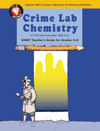Crime Lab Chemistry: Solving Mysteries with Chromatography
Grades 4—8
Written by Jacqueline Barber and Kevin Beals with Carolyn Willard
This all new, updated version of the classic GEMS best seller has been significantly enhanced, with new sessions and added background for the teacher. In this
unit's prime scenario, pegging the pen used to write a ransom
note comes down to chromatography, a technique for separating
mixtures into their (telling) component parts. Poirot never had it this good.
This New GEMS rewrite starts with the classic sessions from the original guide: Challenged to determine which of several black pens was used
to write a ransom note, student-detectives explore the concepts
of solubility, pigments, and separation of mixtures as they
use chromatography to ferret out the culprit. New sessions provide multiple opportunities for students to visualize the molecular nature and behavior of matter, as they create and revise models and consider the advantages and limitations of models.
Ink is one of
many substances for which chromatography is used in science;
the separation of blood and other constituents has become invaluable
in real-world forensic science, and students' fascination with
detective work makes a terrific springboard for further discussion.
Several mystery scenarios are possible, using nefarious characters
drawn from any context you like; many teachers have cast themselves
or the school principal as suspects!
Two excellent connecting GEMS units,
Fingerprinting and Mystery Festival, also draw on detective work and mystery to
explore the very essence of scientific inquiry.
Time: Five 35- to 45-minute sessions plus follow-up sessions.
See the Crime Lab Chemistry online
orientation video.
NSTA Recommends Crime
Lab Chemistry
"This is an exceptionally well-written activity book featuring
two experiments that help students learn the important science
concepts of solubility, pigments, and separation of mixtures
while solving a mystery. …I highly recommend Crime Lab
Chemistry as a great way to introduce students to important
science concepts. The activities are fun and intriguing, but
they require students to use higher levels of thinking and scientific
processes."
–National Science Teachers Association Recommends (Review of the original version of the guide.)
Comment on this GEMS unit.
|

Order
online
Ordering information
What materials are needed to present this unit? See the full list. |

